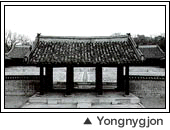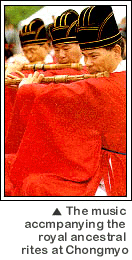 The
Main Hall and the Hall of Everlasting
Peace have the same basic spatial plan
based on repetition, symmetry and symbolism,
though the former is of a somewhat larger
scale than the latter. Permeated by a solemn atmosphere,
the wooden structures are simple and functional with
highly restrained use of decoration, which results
in an austere aestheticism rarely found in Korean traditional
architecture. The steep roofs are imposing and
the round pillars running the entire length of
the facade symbolize the perpetuity of the royal lineage,
while the broad stone terraces add to the mystic
feeling of tranquility. The Main Hall is designated
National Treasure No.227 and the Hall of
Everlasting Peace is Treasure No.821. The
Main Hall and the Hall of Everlasting
Peace have the same basic spatial plan
based on repetition, symmetry and symbolism,
though the former is of a somewhat larger
scale than the latter. Permeated by a solemn atmosphere,
the wooden structures are simple and functional with
highly restrained use of decoration, which results
in an austere aestheticism rarely found in Korean traditional
architecture. The steep roofs are imposing and
the round pillars running the entire length of
the facade symbolize the perpetuity of the royal lineage,
while the broad stone terraces add to the mystic
feeling of tranquility. The Main Hall is designated
National Treasure No.227 and the Hall of
Everlasting Peace is Treasure No.821.
|


Jongmyo is the royal ancestral
shrine of the Choson dynasty (1392-1910)
where the spirit tablets of its kings and
queens are enshrined and memorial rites
are observed in respect of time-old
confucian traditions. the construction of
the shrine, a major state institution
of Korea's last monarchy, began in the ninth
month of 1394 after its founding ruler,
Yi Song-gye or Taejo, chose seoul as
his new capital and was completed in the
twelfth month of the next year. The
shrine was expanded and repaired
on many occasions thereafter to accommodate
the spirit tablets of succeeding kings and
queens. Currently, Chongjon (Main
Hall) has 19rooms ensconcing a total of
49 tablets for kings commanding greater
respect and their queens. Yongnyongjon (Hall
of Everlasting Peace), a smaller annex,
has 16 rooms housing 34tablets of kings
considered not worthy of the Main Hall,
posthumous kings, princes and their wives.
The original structures were all burnt down
by Japanese troops during the Hideyoshi
invasions in 1592-1598. The present buildings
were reconstructed in1608.. |
|

The Main Hall and
the Hall of Everlasting Peace
have the same basic spatial plan
based on repetition, symmetry and
symbolism, though the former
is of a somewhat larger scale than
the latter. Permeated by a solemn
atmosphere, the wooden structures are simple
and functional with highly restrained
use of decoration, which results in
an austere aestheticism rarely found in
Korean traditional architecture. The
steep roofs are imposing and the round
pillars running the entire length of
the facade symbolize the perpetuity
of the royal lineage, while the broad stone
terraces add to the mystic feeling
of tranquility. The Main Hall is designated
National Treasure No.227 and
the Hall of Everlasting Peace is Treasure
No.821. |
|


Chongmyo comprises two major ritual halls
and seven auxiliary structures including
Kongshindang(Hall of Meritorious Officials),
a pavilion where the kings prepared
themselves for rites, warehouses for storing
ritual vessels and incense, and a dressing
room for musicians. The shrine stands out
among Korea's ancient architectural monuments
for its simple and austere style stressing
a solemn atmosphere. Both the Main
Hall and the Hall of Everlasting Peace, each
enclosed with a square wall, consist of
a large rectangular hall with a long
front corridor connecting the individual
rooms. The halls stand on broad two-tiered
stone terraces occupying almost the entire
expanse of the courtyards. Running through
the stone terraces from south to north
is a brick-covered central walkway which
is reserved for the royal spirits.
There is not a single plant in the
two courtyards whereas the rest of the spacious
compound is covered with thick woods, a
deliberate scheme to better expose the halls
to the ethereal energy of the heavens. The
shrine is designated Historic Monument No.125.
|
|

 The
royal ancestral rites at Chongmyo,
designated Intangible Cultural Property
No.56, represent the most majestic court
customs from Korea's last monarchy. The
royal ancestral rites at Chongmyo,
designated Intangible Cultural Property
No.56, represent the most majestic court
customs from Korea's last monarchy.
The solemn but spectacular rite, officiated
by the kings and featuring elaborate music
and dance, were intended to appease the
souls of the deceased rulers and seek their
benevolence for peace and prosperity in the nation.
During Choson times, the rites were observed
frequently around the year, including those
held to offer the new harvest for each of
the four seasons and to report on
major events in the state and court.
The rites were suspended temporarily
during the turbulent years earlier
this century. Nowadays they are held once
a year on the first Sunday of May.
|

|
|
|